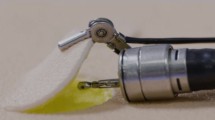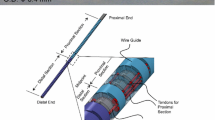Abstract
The tendon-sheath mechanism can be applied to a flexible endoscopic surgery robot because of its flexibility and power transmission. However, the hysteresis, which is the inherent problem with this mechanism, affects the precision of the control of the surgical robot. Despite several studies that are aimed at tackling hysteresis, only a few literatures consider a practical circumstance such as initial unknown hysteresis, proper surgical procedure, and camera illumination. In this study, we propose a novel framework to reduce the hysteresis of a flexible surgical robot using the learning-based hysteresis classification and a feed-forward compensation based on practical scenarios. We empirically discretize and divide the hysteresis class based on its size and show the correlation between hysteresis and time-series wire tension experimentally to study its potential for use in real surgical robots. The results indicate that the hysteresis can be classified by utilizing the time-series wire tension data. Moreover, the proposed compensator could enhance the performance of a real-size flexible endoscopic surgery robot based on actual surgical environment.








Similar content being viewed by others
References
Hwang, M., & Kwon, D.-S. (2020). K-flex: a flexible robotic platform for scar-free endoscopic surgery. The International Journal of Medical Robotics and Computer Assisted Surgery, 16(2), 2078.
Nageotte, F., Zorn, L., & Zanne, P., & De Mathelin, M. (2020). Stras: A modular and flexible telemanipulated robotic device for intraluminal surgery. Handbook of robotic and image-guided surgery (pp. 123–146). USA: Elsevier.
Légner, A., Diana, M., Halvax, P., Liu, Y.-Y., Zorn, L., Zanne, P., Nageotte, F., De Mathelin, M., Dallemagne, B., & Marescaux, J. (2017). Endoluminal surgical triangulation 2.0: A new flexible surgical robot. preliminary pre-clinical results with colonic submucosal dissection. The International Journal of Medical Robotics and Computer Assisted Surgery 13(3), 1819.
Schuler, P. J., Hoffmann, T. K., Veit, J. A., Rotter, N., Friedrich, D. T., Greve, J., & Scheithauer, M. O. (2017). Hybrid procedure for total laryngectomy with a flexible robot-assisted surgical system. The International Journal of Medical Robotics and Computer Assisted Surgery, 13(2), 1749.
Berthet-Rayne, P., Gras, G., Leibrandt, K., Wisanuvej, P., Schmitz, A., Seneci, C. A., & Yang, G.-Z. (2018). The i 2 snake robotic platform for endoscopic surgery. Annals of biomedical engineering, 46(10), 1663–1675.
Do, T., Tjahjowidodo, T., Lau, M., & Phee, S. (2015). Nonlinear friction modelling and compensation control of hysteresis phenomena for a pair of tendon-sheath actuated surgical robots. Mechanical Systems and Signal Processing, 60, 770–784.
Kim, H., Hwang, M., Kim, J., You, J. M., Lim, C.-S., & Kwon, D.-S. (2020). Effect of backlash hysteresis of surgical tool bending joints on task performance in teleoperated flexible endoscopic robot. The International Journal of Medical Robotics and Computer Assisted Surgery, 16(1), 2047.
Liu, H., Farvardin, A., Pedram, S.A., Iordachita, I., Taylor, R.H., & Armand, M. (2015). Large deflection shape sensing of a continuum manipulator for minimally-invasive surgery. In: 2015 IEEE international conference on robotics and automation (ICRA), pp. 201–206. IEEE.
Omisore, O.M., Han, S., Zhou, T., Al-Handarish, Y., Du, W., Ivanov, K., & Wang, L. (2019). Learning-based parameter estimation for hysteresis modeling in robotic catheterization. In: 2019 41st annual international conference of the IEEE engineering in medicine and biology society (EMBC), pp. 5399–5402. IEEE
Reilink, R., Stramigioli, S., & Misra, S. (2013). Image-based hysteresis reduction for the control of flexible endoscopic instruments. Mechatronics, 23(6), 652–658.
Baek, D., Seo, J.-H., Kim, J., & Kwon, D.-S. (2019). Hysteresis compensator with learning-based pose estimation for a flexible endoscopic surgery robot. In: 2019 IEEE/RSJ international conference on intelligent robots and systems (IROS), pp. 2983–2989. IEEE
Baek, D., Seo, J.-H., Kim, J., & Kwon, D.-S. (2020). Hysteresis compensator with learning-based hybrid joint angle estimation for flexible surgery robots. IEEE Robotics and Automation Letters, 5(4), 6837–6844.
Baek, D., Nho, Y.-H., & Kwon, D.-S. (2021). Vio-com: Feed-forward compensation using vision-based optimization for high-precision surgical manipulation. IEEE Robotics and Automation Letters, 7(1), 263–270.
Do, T., Tjahjowidodo, T., Lau, M., Yamamoto, T., & Phee, S. (2014). Hysteresis modeling and position control of tendon-sheath mechanism in flexible endoscopic systems. Mechatronics, 24(1), 12–22.
Porto, R.A., Nageotte, F., Zanne, P., & de Mathelin, M. (2019). Position control of medical cable-driven flexible instruments by combining machine learning and kinematic analysis. In: 2019 international conference on robotics and automation (ICRA), pp. 7913–7919. IEEE
Hong, J., Hong, D., & Kim, B.G. (2020). Modeling backlash-like hysteresis of tendon sheath mechanism-pair. Journal of Mechanisms and Robotics 12(4)
Do, T., Tjahjowidodo, T., Lau, M., & Phee, S. (2015). Adaptive control for enhancing tracking performances of flexible tendon-sheath mechanism in natural orifice transluminal endoscopic surgery. Mechatronics, 28, 67–78.
Lee, D.-H., Kim, Y.-H., Collins, J., Kapoor, A., Kwon, D.-S., & Mansi, T. (2021). Non-linear hysteresis compensation of a tendon-sheath-driven robotic manipulator using motor current. IEEE Robotics and Automation Letters, 6(2), 1224–1231.
Lee, D.-H., Hwang, M., Kim, J., & Kwon, D.-S. (2020). Payload optimization of surgical instruments with rolling joint mechanisms. In: 2020 IEEE/RSJ international conference on intelligent robots and systems (IROS), pp. 3131–3136. IEEE.
Hatami, N., Gavet, Y. & Debayle, J. (2018). Classification of time-series images using deep convolutional neural networks. In: tenth international conference on machine vision (ICMV 2017), vol. 10696, p. 106960. International Society for Optics and Photonics
Ismail, M., Ikhouane, F., & Rodellar, J. (2009). The hysteresis bouc-wen model, a survey. Archives of computational methods in engineering, 16(2), 161–188.
Gaur, A., Mittal, A., Ghosh, D., & Sahoo, J. (2019). Challenges in development of colon drug delivery system with repect to dissolutions studies. World J. Pharm. Pharmaceut. Sci., 8(6), 1465–1491.
Murtagh, F. (1991). Multilayer perceptrons for classification and regression. Neurocomputing, 2(5–6), 183–197.
Li, X., Tiong, A. M. H., Cao, L., Lai, W., Phan, P. T., & Phee, S. J. (2019). Deep learning for haptic feedback of flexible endoscopic robot without prior knowledge on sheath configuration. International Journal of Mechanical Sciences, 163, 105129.
Wei, Z., Xiang, B. L., & Ting, R. X. (2014). Online parameter identification of the asymmetrical bouc-wen model for piezoelectric actuators. Precision Engineering, 38(4), 921–927.
Acknowledgements
This work was supported by the Korea Medical Device Development Fund grant funded by the Korea Government (the Ministry of Science and ICT, the Ministry of Trade, Industry and Energy, the Ministry of Health & Welfare, Republic of Korea, the Ministry of Food and Drug Safety) under Project 202012D18.
Author information
Authors and Affiliations
Corresponding author
Additional information
Publisher's Note
Springer Nature remains neutral with regard to jurisdictional claims in published maps and institutional affiliations.
Rights and permissions
Springer Nature or its licensor (e.g. a society or other partner) holds exclusive rights to this article under a publishing agreement with the author(s) or other rightsholder(s); author self-archiving of the accepted manuscript version of this article is solely governed by the terms of such publishing agreement and applicable law.
About this article
Cite this article
Lee, DG., Baek, D., Kim, H. et al. Learning-Based Discrete Hysteresis Classifier Using Wire Tension and Compensator for Flexible Endoscopic Surgery Robots. Int. J. Precis. Eng. Manuf. 24, 83–94 (2023). https://doi.org/10.1007/s12541-022-00716-0
Received:
Revised:
Accepted:
Published:
Issue Date:
DOI: https://doi.org/10.1007/s12541-022-00716-0




